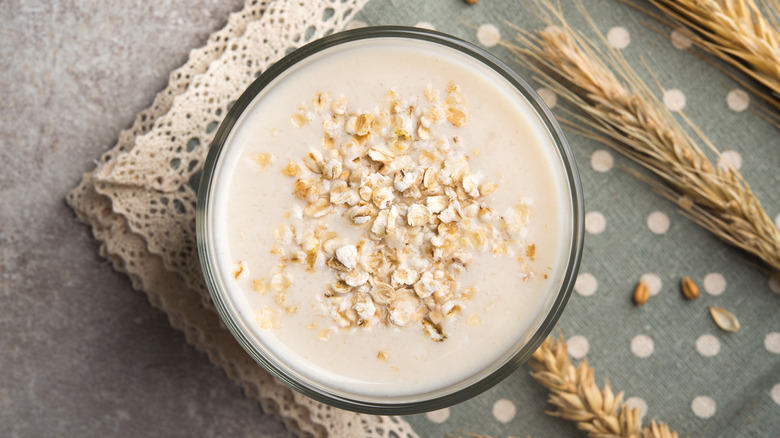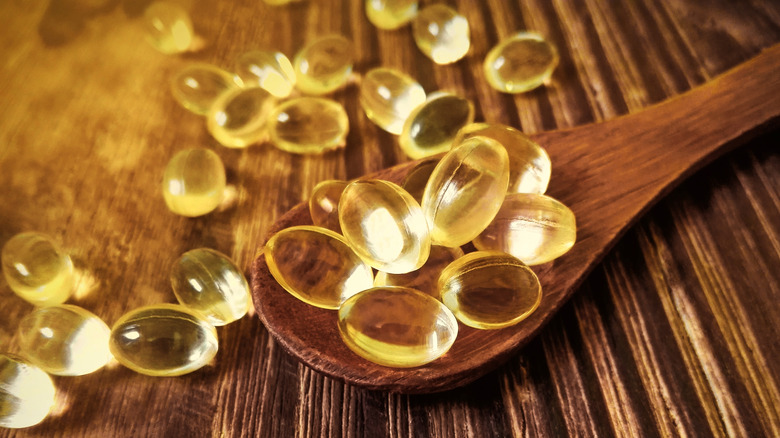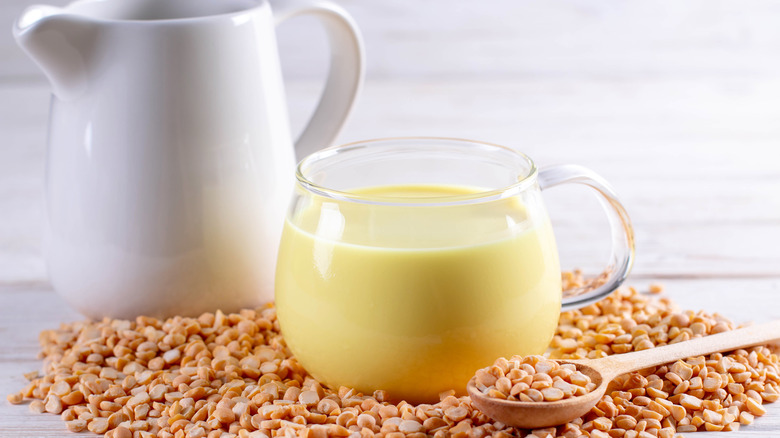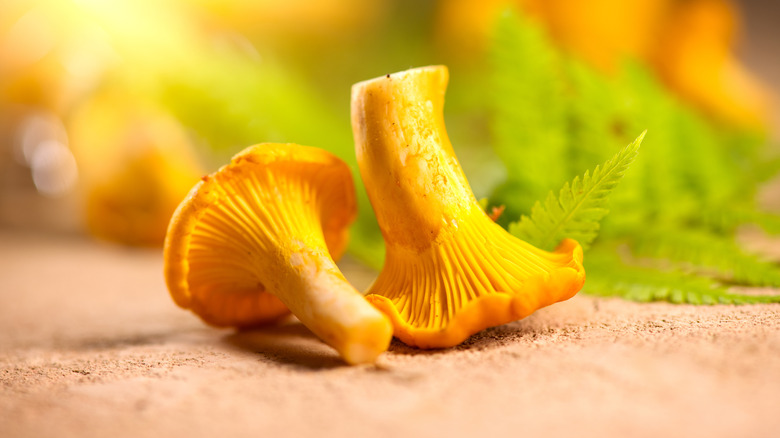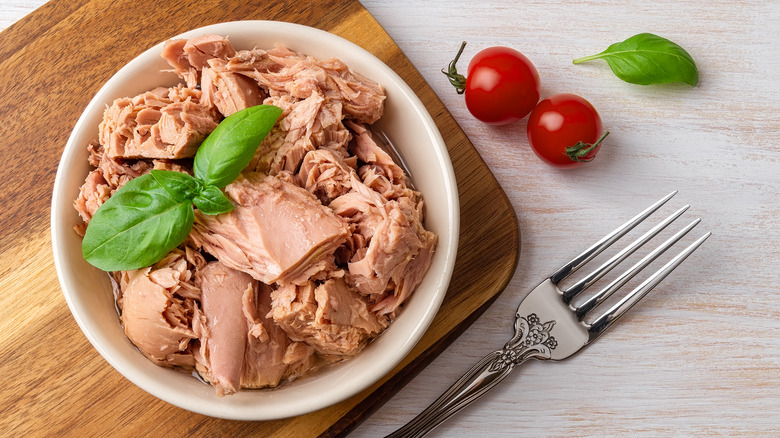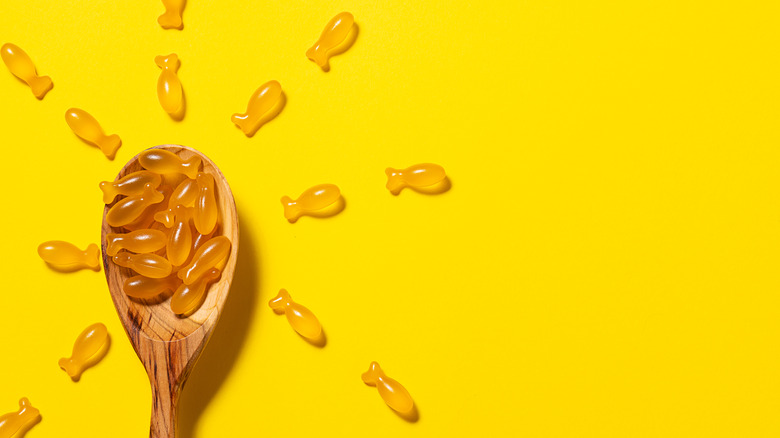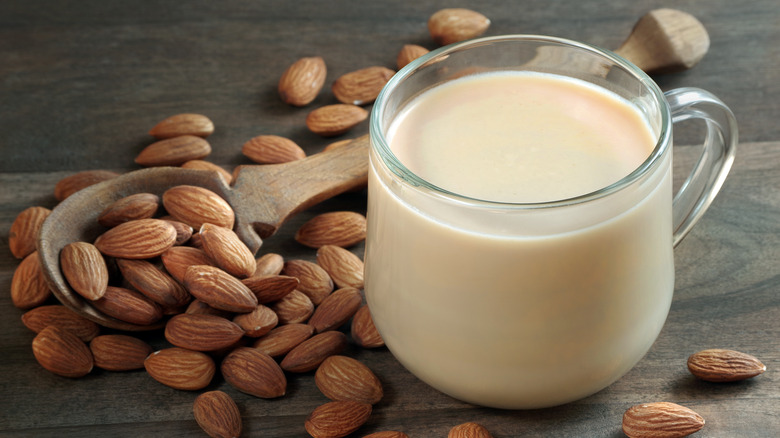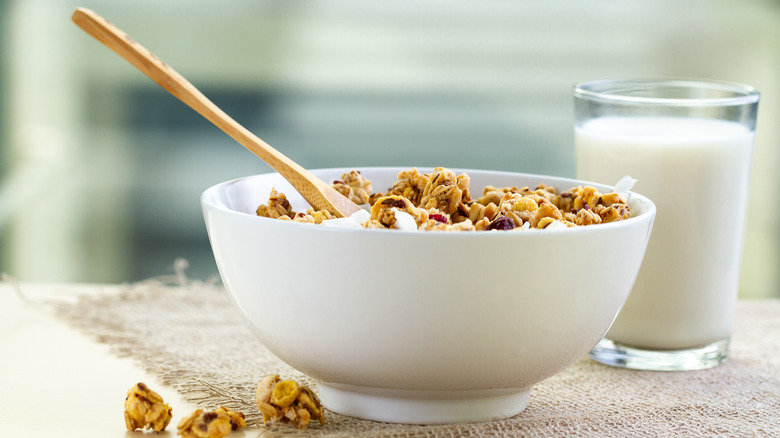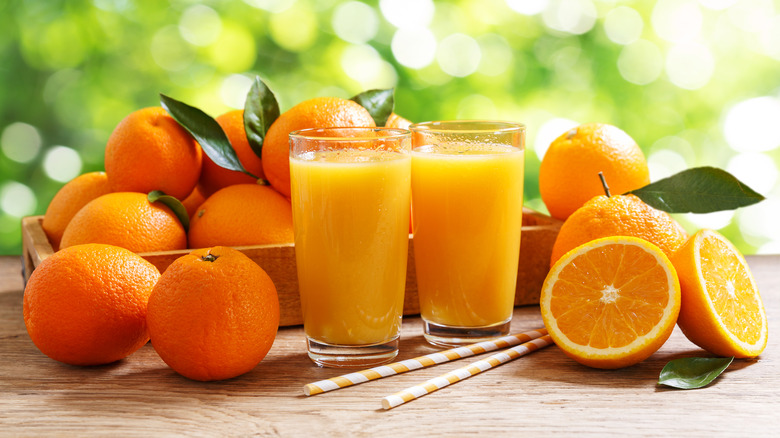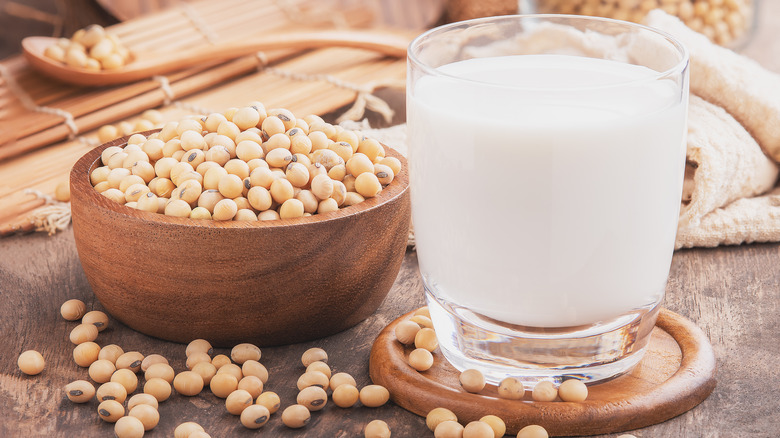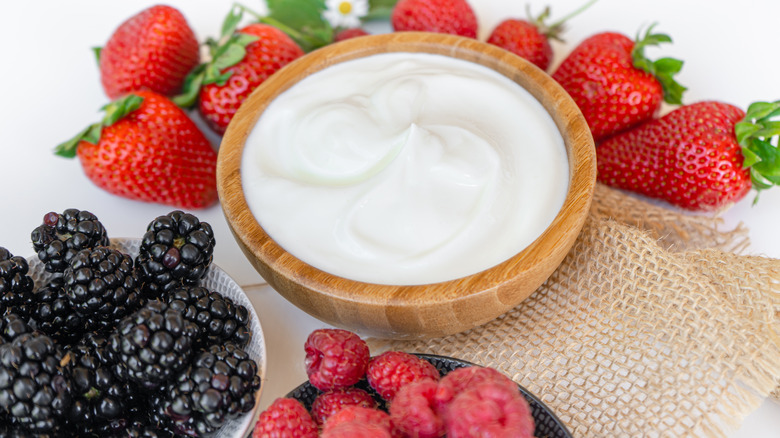All The Ways You Can Get Vitamin D
Did you know that there are two different types of vitamin D? As Healthline explains, vitamin D3, or cholecalciferol, comes mainly from animal-based foods. On the other hand, D2, or ergocalciferol, is naturally found in plant-based foods, as well as foods that have had it added during the manufacturing process (commonly called fortified foods). And while this might not sound like a big difference, it can impact your vitamin D levels.
Even though D3 and D2 are both converted by your liver into calcifediol (aka the vitamin D that circulates throughout your body), humans absorb D3 calcifediol better than the D2 version (via Healthline). Now, to be clear, this doesn't make D2 a bad choice if you want to up your vitamin D levels. But it could mean there are better choices for you — especially if you're concerned about vitamin D deficiency, an ailment that can impact your immune and nervous systems, as well as your muscles and bones (via MedlinePlus).
While choosing D3-rich food can be a good way to keep your vitamin D levels steady, diet is just one of three ways your body gets vitamin D (via MedlinePlus). Let's explore foods that contain the important vitamin as well as the additional methods of upping your vitamin D levels.
Oat milk
If you have a nut allergy or are lactose intolerant but are looking for a beverage that contains vitamin D, then you might want to opt for oat milk (via WebMD). This creamy plant-based drink is not only usually fortified with vitamin D, as well as other nutrients like vitamin A, calcium, and riboflavin, but also is a natural source of iron. However, this popular dairy substitute does have a few drawbacks that you should be aware of before trying it.
As functional medicine dietitian Jorden Edinger explains, oat milk edges out other milks made from plants in terms of its protein and fiber (via Cleveland Clinic). However, cow's milk still has around double the protein of oat milk and more essential amino acids, which are crucial for your cells, as well as your body's chemistry (via MedicineNet). In addition, oat milk can be loaded with carbohydrates and calories especially when compared to other plant-based options on the market.
With that all that said, oat milk can be a good addition to your diet, especially if you have concerns about your bone health. According to WebMD, the fact that manufacturers typically add both vitamin D and calcium to oat milk can help keep your bones strong and healthy. And one final piece of advice: Although vitamin A and riboflavin are commonly added to oat milk, not every brand does this, so make sure to check food labels.
Supplements
Of course, if you're concerned that you need more of a particular vitamin, taking supplements can be a good partial solution. And, as Healthline points out, even vegan-related dietary restrictions are not obstacles if you want to start taking vitamin D supplements. After all, vitamin D2 comes from plants, not animals. However, there are a few things you should keep in mind before adding any vitamin D supplements to your vitamin regime.
If you opt for supplements made from vitamin D2 (aka ergocalciferol), remember that the human body works better with vitamin D3 (cholecalciferol), which mainly comes from animals (via Healthline). Besides what type of vitamin D is in a supplement, you should keep two words in mind when picking a supplement brand: "purity and quality," according to Healthline. In other words, if a supplement isn't tested for these two characteristics, then you probably should choose a different brand. In addition, you should check with your health care professional and have your vitamin D levels tested, so you can select the right supplement dosage for your health needs.
Ripple milk (pea milk)
Over the years, a number of non-dairy products have become mainstream. Even Dunkin' Donuts jumped on the bandwagon when it added oat milk to its menu. And joining the list of cow's milk alternatives is a beverage made from peas. Yes, you read that right.
According to Healthline, the main ingredient in Ripple milk, which is named after its manufacturer, Ripple Foods, is yellow peas. And besides being a good source of iron, calcium, and protein, Ripple milk is fortified with vitamin D. However, there is one small catch. The type of vitamin D typically added to Ripple milk is D2, not D3. Remember, vitamin D3 comes mainly from animals while D2 comes from plants (via Healthline). Because of this our bodies usually respond better to D3 than to D2. So, while consuming Ripple milk can help raise vitamin D levels in your body, it probably won't do so as well as a product that contains vitamin D3.
In addition to being fortified with D2 instead of D3, Ripple milk has one more ingredient that you need to be cautious about consuming in excess: sunflower oil (via Healthline). Why? Because sunflower oil has omega-6 fatty acids, and too much of this type of fat can lead to issues with your heart, as well as diabetes. Also, like many dairy alternatives, you should always check the food label for sugar content.
Mushrooms
Whether you eat them in salads, soups, or on pizza, mushrooms are a widely available potential source of vitamins. However, before you rush off to the supermarket, there is some serious "fine print" when it comes to these fungi and vitamin D. And it all circles back to how they're grown.
According to The Nutrition Source, the amount of vitamin D can be notably lower in store-bought mushrooms. This is because mushroom manufacturers typically grow their fungi in areas with low lighting. The problem with this approach is these mushrooms have limited (if any) exposure to sunlight, which impacts how much vitamin D they produce. However, some manufacturers do use ultraviolet (UV) lamps or natural sunlight, leading to mushrooms with higher levels of vitamin D2. But this brings us to another slight downside to mushrooms and vitamin D.
While either D2 or D3 are good sources of vitamin D, our bodies tend to work better with the D3 variety (via The Nutrition Source). In addition, how mushrooms are prepared can also alter how much vitamin D they contain. For example, using oils to sauté them could actually drop their vitamin D content since the oil can draw the vitamin out of the mushrooms during the cooking process. And one more big word of caution: Some varieties of mushrooms are poisonous, so even though mushrooms growing in the wild can be exposed to more sunlight, they also can be dangerous to consume.
Sunlight and UV lamps
While eating certain foods can be a great way to increase your vitamin D levels, don't forget, your skin can also help you boost this essential nutrient (via MedicineNet). This is because our skin contains cholesterol, but don't worry, not all cholesterol is bad.
As MedicineNet explains, the cholesterol in our skin reacts to the sun's ultraviolet or UV radiation, helping our bodies make vitamin D. And if you guessed that our skin responds similarly to UV lamps, you'd be right. In fact, ultraviolet lamps are especially useful for people who don't get enough sunlight due to reasons like occupation or location.
Although sunlight and UV lamps can both be good ways to raise the levels of vitamin D in your body, there are some important things to keep in mind. For one, how long and how much your body is exposed to them, as well as age and skin tone, can impact how much vitamin D your body produces from exposure to UV rays (via MedicineNet). Also, using sunscreen could reduce how much vitamin D your skin produces (via Harvard Health Publishing). But this brings us to a major concern: UV radiation can cause skin cancer (via American Cancer Society). Do not skip your sunblock or overdo your exposure to the sun or UV lamps just to increase your vitamin D.
Fish
Despite concerns regarding mercury, fish can be a great addition to your diet especially if you're looking to raise your vitamin D levels (via Everyday Health). And that's a good thing too because no matter what your taste, there's probably a type of fish you'll enjoy.
Good Housekeeping, for example, singles out flounder and sole as great sources of vitamin D. But if you want a stronger flavor in the "surf" part of your "surf and turf," then registered dietitian Lori Zanini recommends sockeye salmon, telling Everyday Health, "In addition to vitamin D, salmon is a great addition to anyone's diet, with it also being a good source of healthy protein and omega-3 fatty acids." Another flavorful and extremely easy-to-find vitamin D-rich fish is canned tuna, which has a whopping 154 IU of vitamin D for every 3 ounces (via Oprah Daily).
In addition, Zanini also recommends swordfish if you want to boost your vitamin D levels. However, the American Heart Association (AHA) does caution that the larger the fish and the longer its lifespan, the more mercury it's bound to contain (via Everyday Health). If you're expecting, you might want to choose a different fish to meet your vitamin D needs. And one more word of advice: Besides pregnant women, the AHA also warns against children eating fish high in mercury.
Cod liver oil
While cod might not be packed with as much vitamin D as other flatfish, according to Good Housekeeping, cod liver oil is an excellent way to boost your levels of this nutrient (via WebMD). In fact, it's been a "home remedy" for vitamin D deficiency for hundreds of years. But just because it's got a good track record doesn't mean it's good for everyone.
According to WebMD, the high amount of vitamin A in cod liver oil could be unhealthy for a baby still developing in the womb. Therefore, if you or someone you know is pregnant, you might want to explore other vitamin D options. Also, if you're on a blood thinner, then cod liver oil can lead to a life-threatening situation. How? Because it can interact with the medication, making it stronger than normal. But with all that said, cod liver oil has some major benefits even beyond its vitamin D content.
The vitamin A in cod liver oil can also support your eyes and cells, as well as your reproductive and immune systems (via WebMD). In addition, cod liver oil contains omega-3 fatty acids, giving it anti-inflammatory properties. Plus, regularly taking this oil might reduce your chances of developing certain health problems like multiple sclerosis, glaucoma, and cancer. And if you've already developed glaucoma or have rheumatoid arthritis, cod liver oil could be a valuable part of your treatment and management regime for these conditions.
Eggs (and not just from chickens)
While some of the foods on this list are fortified with vitamin D, eggs (particularly large eggs) come naturally packed with this nutrient, according to WebMD. In fact, eggs are great sources of not just vitamin D but also vitamin B12, as well as other nutrients like zinc, iron, biotin, calcium, selenium, iodine, and pantothenic acid. In addition, eggs are rich in protein. However, there is one more substance found in eggs that has been a bit controversial over the years.
As WebMD points out, a large egg can contain 185 grams of cholesterol. Because of this, eggs have been branded as diet don'ts for anyone with cholesterol-related health concerns. But this school of thought has shifted, and what it boils down to (no egg pun intended) is the type of fats one consumes. Trans fat, which is not the type found in eggs, can raise the less healthy type of cholesterol in your body. The fat found in eggs, however, can actually help support your heart's health.
Even though eggs are no longer a major concern when it comes to cholesterol, you should still talk with your health care professional about adding them to your diet. And don't limit your conversation to just chicken eggs. Duck eggs, for example, have higher levels of vitamin A and omega-3 fatty acids than chicken eggs (via WebMD). And, yes, they're also a great source of vitamin D, as well as a host of B vitamins.
Beef liver
For some, offal can be off-putting, even if they eat meat. Nevertheless, adding beef liver to your diet is a good way to increase your vitamin D levels. As Medical News Today explains, cow liver is also a good source of not just protein but nutrients like vitamin A, vitamin C, iron, copper, selenium, zinc, and phosphorus. And, of course, it also contains vitamin D3, which our bodies have an easier time processing than D2 (via the U.S. Department of Agriculture). Because of this, consuming beef liver could be beneficial for your body in a variety of ways including supporting your nervous, reproductive, and immune systems, as well as your cells in general.
While beef liver can be a good addition to one's diet in part because of its vitamin D content, it may also contain antibiotics, which can cause antibiotic resistance (via Medical News Today). If this occurs, then a person can experience a potentially life-threatening reaction known as anaphylaxis. In addition, taking in either too much vitamin A or too much copper (both of which are in beef liver) can be dangerous. So, portion control is crucial when it comes to beef liver.
Almond milk
Unless you've been living under a rock, you've heard of almond milk. This incredibly popular beverage is often used instead of cow's milk in everything from smoothies to that morning cup of coffee. But there is one important word to keep in mind when it comes to this plant-based milk: enriched.
As Medical News Today explains, unenriched almond milk, which is made either from almonds or almond butter, doesn't measure up to cow's milk when it comes to nutritional value. So, making your own almond milk at home probably isn't going to help you up your vitamin D that much (although it might be a good way to help boost your vitamin E). However, the enriched version of this milk is almost on par with its dairy cousin, offering not only vitamin D but also protein and calcium. But there is one little catch to buying this type of almond milk.
While different manufacturers of almond milk might up its nutritional content, how much of a particular vitamin or mineral they add can differ (via Medical News Today). So, even if a product advertises in big bold letters that it's "enriched with vitamin D," it's still a good idea to check its nutrition label for how much and what type of vitamin D it contains.
Cow's milk
When making yourself a bowl of cereal or oatmeal, have you ever wondered why vitamin D is added to cow's milk? Yes, in some countries it's illegal not to do so, but in the U.S., it's completely up to manufacturers (via Healthline). And yet even though it adds time and expense to readying the milk for the market, the majority of milk producers in the United States choose to fortify milk with vitamin D. Why? The answer can be summed up in one word: rickets.
According to the Mayo Clinic, rickets usually occurs in children who don't have enough vitamin D. Since vitamin D helps bones take in calcium, this can lead to weaker bones and even skeletal deformities. This is why in the 1930s manufacturers began fortifying cow's milk with vitamin D (via Healthline). In fact, a single cup of fortified 2% cow's milk can give you 26% of the recommended daily amount of vitamin D. Nonfat, 1%, and whole milk are all also good sources of vitamin D if they're fortified.
Orange juice
While fortified cow's milk can be a good source of vitamin D, it also could be an issue for someone who is lactose intolerant since they have difficulty digesting the sugar naturally found in milk (via Reuters). Fortunately, dairy products aren't the only foods that have been fortified with extra vitamins. And while there can be complications when adding vitamin D to food, a study has found that fortified orange juice could be an effective way to help up your vitamin D levels.
Before we get into the study's findings, it's important to understand a school of thought regarding foods fortified with additional vitamins (via Reuters). Basically, it all comes down to one question: Is a specific vitamin fat-soluble or water-soluble? In other words, does the vitamin dissolve in fat or water? Since vitamin D is fat-soluble, it's been presumed that adding it to foods with notable fat content would best help our bodies absorb it.
But not so fast, the study that compared drinking vitamin D-fortified orange juice to taking vitamin D supplements found both equally raised the participants' vitamin D levels (via Reuters). Keep in mind that, unlike cow's milk, orange juice is not a high-fat beverage. So, if you need to raise your vitamin D levels but have dietary restrictions when it comes to dairy or are vegan and don't eat or drink animal-based products, you might want to try adding orange juice to your diet.
Soy milk
Like so many foods, soy products have been at the center of debate (via U.S. News & World Report). On the one hand, many manufacturers fortify it with vitamin D (via Healthline). In fact, 1 cup of fortified soy milk can provide someone with as much as 15% of the recommended daily amount of this nutrient. However, there are a number of possible pros and cons connected to soy.
As registered dietitian Gabrielle Mancella told U.S. News & World Report, "Soy is the closest thing to a complete protein." She also said its low sugar and fat content is another benefit for one's health and so recommends the unsweetened, as well as the organic and non-GMO (genetically modified organism), varieties. But besides fortified soy milk containing vitamin D, soy products in general also have a substance called phytoestrogens, and this is where things get a little complicated.
All humans have the hormone estrogen, and phytoestrogens from soy are debatably believed to trick your body's estrogen receptors (via U.S. News & World Report). In other words, these receptors might react to the phytoestrogens as if they were your own estrogen. And if you have low estrogen, then soy (in theory) could be helpful. However, since there have been conflicting findings from studies (some saying phytoestrogen increases the chances of developing cancer while others saying they decrease it), you should speak with a health care professional before adding soy products to your diet.
Yogurt
If your friend asked you what ice cream you want, would you reply, "I don't care, ice cream's all the same"? You probably wouldn't say at least the second part of that sentence. Why? Because there are so many flavors. And just as you can't randomly swap out chocolate for vanilla, not all yogurt products are the same when it comes to vitamin D (via Shape).
But first, a little Yogurt 101: While this fermented food is not a natural source of vitamin D, it does naturally have calcium (via Shape). Remember, vitamin D helps your bones take in calcium, which is crucial for their strength and health (via Mayo Clinic). But as registered dietitian Jackie Newgent explained to Shape, "The levels [of vitamin D] can vary widely from brand to brand, so you really need to check the label." Also, yogurts sometimes use different types of milk and process that milk in different ways, resulting in very distinct products. For example, Greek yogurt has more protein and is thicker and creamier than traditional yogurt because manufacturers don't remove its whey protein.
Besides being a good source of protein, calcium, and vitamin D, yogurt, in general, is rich in nutrients like zinc and potassium, as well as B vitamins like riboflavin, B5, and B12 (via Shape). Because of its nutritional content, yogurt might support your digestive and immune systems. Also, it has been shown to help with blood pressure issues.


